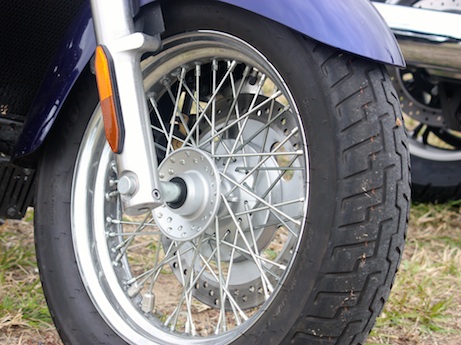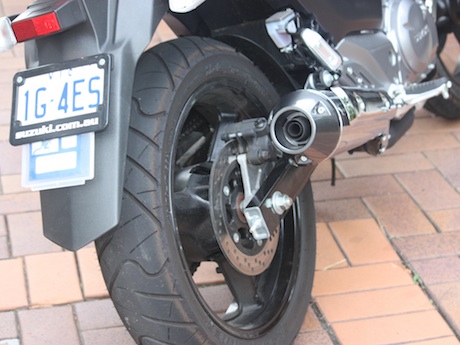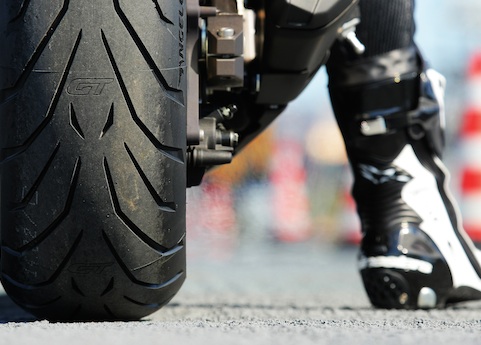What are the correct tyre pressures for your motorcycle and do they vary for any reason? The answers are varied and complex.
You should check your tyre pressures every time you go out for a ride or it can result in bad handling, increased wear, fatigue cracking, increased chance of a puncture, decreased grip and lower braking performance.
The first and most important point is that you should follow the pressures stated by the motorcycle manufacturer for any particular motorcycle. You can find them in your user manual or on the placard attached to the bike. Usually there are two recommendations, one for solo and one for two-up with only 1-2psi difference, usually higher on the rear.
Varied tyre pressures have less to do with providing a cushion of air for support and more to do with heat. Tyres need to warm up to an optimum temperature where their grip level is high and wear is low. To achieve the right temperature, the tyres have to be inflated to the right pressure.
If you change to a different brand of tyre, then check the tyre manufacturer’s advised pressures.

Lower pressures
Some riders prefer lower pressures because they believe it gives them more grip as the tyre spreads and creates a larger footprint. Others like the better ride comfort of a lower pressure.
However, lower pressures than recommended (even by a very small margin) can increase the amount of heat generated within a tyre, even after short riding distances. This can affect the compound and accelerate wear on the tyre. These lower pressures also affect the shape and contact area of the tyre under load, dramatically affecting performance and handling, even over short riding distances. So lower pressures are not recommended for performance and safety reasons.
Over-inflating tyres is also not recommended. It doesn’t increase load-carrying capacity, but results in a hard ride and accelerated tyre wear in the centre of the contact patch.

Manufacturers’ recommendations
The issue of correct tyre pressures becomes a bit more complex when you look at it from the point of view of the tyre manufacturers. While motorcycle manufacturers tend to simplify their recommendations, some tyre manufacturers can supply a variety of pressures depending on maximum speed, maximum load and sometimes even ambient temperature. This is more important in places such as Europe where roads can be icy and autobahns can have very high speed limits. In normal use, tyre manufacturers’ recommended pressures won’t vary much from motorcycle manufacturers’ recommendations.
If you are an aggressive rider who corners hard, carries heavy loads or rides at sustained high speeds, you may consider slightly higher pressures than the motorcycle manufacturer recommends, but make sure they are no higher than indicated on the tyre sidewall.
To measure tyre pressures, always check them cold prior to riding. Once the tyre heats up from use, the pressures will rise, so the reading will be inaccurate. Recommended pressures in your user manual are always presumed to be taken when the tyre is cold.
Check your gauge
You would think service stations would have accurate gauges on their air hoses, but investigations by automobile clubs and our own checks have revealed substantial inaccuracies.
More than a third of the mechanical units are from 5% to almost 20% inaccurate. Whereas up to 95% of the electronic units are within 5% accuracy.
Instead, use your own gauge. Digital tyre gauges or tyre inflators/gauge combinations are often more expensive and seem like better quality, but they can lose correct calibration over time and run out of battery. Analog or physical dial gauges are often more accurate for longer.
I like the simple and cheap pen-sized gauge that members can get free from the RACQ. They are accurate and very small.
The most accurate I have found is the Rocky Creek Designs MotoPressor gauge ($25). It also comes with a short length of tube so you can attach it to rims that can be difficult to access with most garage air pumps.
[asa2_img img=”1″ size=”LargeImage” width=”500″ height=”500″ show_title=”yes” show_button=”yes” tpl=”Image_Layout_1″ associate_id_set=”MBW”]B07DX9XJDP[/asa2_img]Track tyre pressures
Track riders say they lower their tyre pressures when they hit the race track. However, if they are using street tyres – even very sporty tyres – pressures should remain the same as for road use.
The reason is that all of these street tyres are designed to work their best and within their application, design and construction parameters at normal manufacturer recommended pressures. If you lower pressures you will see the same reduced performance and increased safety concerns results as on the road.
However, if you have special track tyres w=you will see that they are recommended to be run at lower pressures, anyhow.
Thankfully there are now many sports and touring tyres that overlap in their capabilities. For example, the Pirelli Angel GT is not only a very good touring tyre with long wear and high road grip, but is also very capable for track work. However, you still need to stick to the recommended pressures.
Purpose-made race tyres have a completely different construction and are designed for maximum grip, rather than long wear and will have specific guidelines for pressures. It’s a black art that race engineers have studied for years. There is no simple rule. Go and experiment.
[asa2_img img=”1″ size=”LargeImage” width=”500″ height=”500″ show_title=”yes” show_button=”yes” tpl=”Image_Layout_1″ associate_id_set=”MBW”]B07VV78RZ1[/asa2_img]Off-road pressures
As for off-road use, dropping tyre pressures is often recommended, but over-simplified. For example, a lower pressure on a gravel road might give you better grip, but it also exposes the sidewalls to sharp rocks which can damage and deflate the tyre. In this case, drop the pressures marginally and try to retain the integrity of the tyre wall shape.
However, soft and slippery surfaces such as mud and sand, require much lower pressures. Sand requires the lowest pressures, sometimes down to about 12psi, however, be careful that non-tubed tyres don’t pop the bead or roll off the rim.
[asa2_img img=”1″ size=”LargeImage” width=”500″ height=”500″ show_title=”yes” show_button=”yes” tpl=”Image_Layout_Polaroid” associate_id_set=”MBW”]B01J580F2K[/asa2_img]

